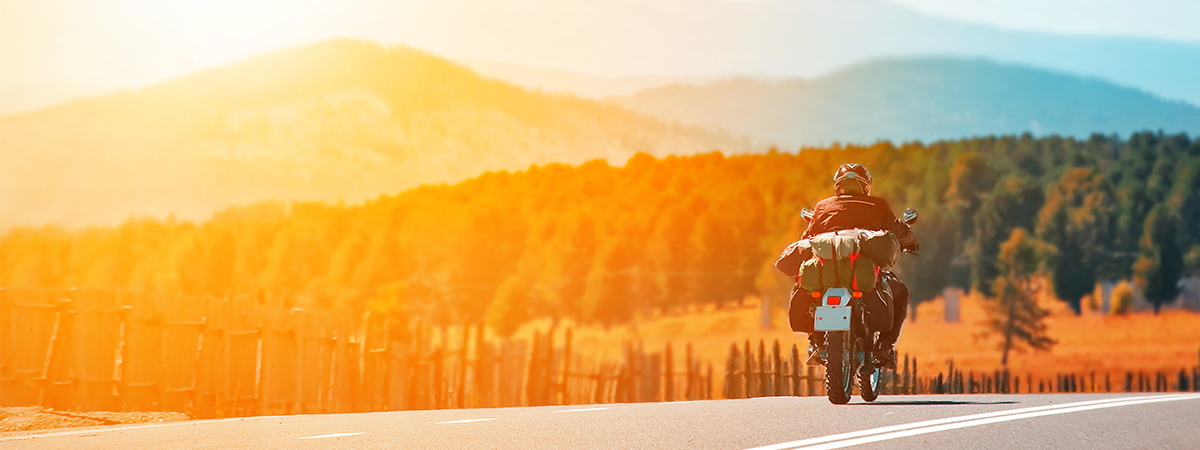
If you’re planning to take an extended motorcycle ride this summer—whether it’s an overnight jaunt up north or a cross-country expedition to the coast—it’s important to ensure your bike is prepared for the voyage ahead.
Read below to see our tips on how to get the most out of your next motorcycle road trip.
Pre-Ride Checklist
Before hitting the road, run through your pre-ride checklist to ensure your bike is ready to go the distance. If you’re a seasoned rider, you may be familiar with the detailed T-CLOCS checklist, which takes you through all the components of your bike that should be inspected before your departure.
Here are a few additional items to check off your list before you go:
- Top up all your fluids, including engine/transmission oil, coolant and brake fluid.
- Ensure your filters are clean and replace if needed.
- Clean your windshield.
- Make sure your seat is secure and comfortable.
- Have your drivetrain lubricated.
- Make sure your battery has enough power to get you to your destination.
Packing Tips to Transform Your Touring Experience
You’re days away from your road trip adventure and it’s time to start packing your bags. Here are our top tips to ensure your trip goes smoothly:
Pack Light
There’s a variety of luggage carriers for motorcycles available, with the most popular being saddlebags, tank bags and tail bags. Each of these bags have limited space so no matter which you choose, you’ll have to pack light. Decide what’s most essential for you to bring on your trip and what you can do without. Book accommodations that include laundry facilities or stop off at a laundromat so you can cut down on the number of clothing items you need to pack.
Dress Appropriately
Wearing proper riding gear can protect you in the case of an accident and minimize injuries. Your most important piece of gear is a full-face helmet to protect against head injuries, windblast and flying objects or bugs. Riding pants and a long sleeve shirt or jacket will help to prevent sunburn, road rash and windburn. Light colours or reflective clothing will also help to increase your visibility. Wearing boots will shield you from foot or ankle injuries and provide good grip on the foot pegs. And if you’re expecting a bumpy ride, consider wearing elbow and knee guards. It’s also never a bad idea to pack a raincoat just in case you get caught in an unexpected shower.
Bring Water for the Ride
Staying hydrated may seem obvious, but it’s not necessarily something you’d think about when considering all the important aspects of a motorcycle road trip. Drinking tons of water before you leave or at a rest stop can increase the likelihood of stomach cramping while you’re on the road. Consider purchasing a hands-free hydration pack. It includes a fillable pouch that keeps your water cold and comes with a long tube so you can drink at a moderate pace while you drive.
Don't Forget the Map
Before you go, be sure to review the directions to your destination. If you prefer to follow a GPS as you ride, consider getting a handlebar mount for your phone. If you want to take it one step further, invest in a helmet with Bluetooth so that it can provide you the directions.
In case you are travelling to remote areas with no network, carry some hardcopy maps or download a map of the area you’re travelling from Google Maps to navigate offline.
Consider Earplugs
Sometimes it can get really loud on the highway, especially at peak traffic times. And when travelling at higher speeds, the wind noise can expose you to sound levels in excess of 100 dB, which is the same as using a chainsaw or standing in the middle of the dance floor at a club. Once you hit the main road, put in some earplugs to avoid hearing damage and ear fatigue.
Ride in Comfort
There’s plenty of options for ergonomic aftermarket gear that can make your long-distance ride more comfortable. If you tend to ride early in the morning or late into the evening, heated grips might be a wise investment. Padded grips are also a good choice to help reduce wrist pain and tightness. For more seat comfort, consider gel seats or a backrest. If you’re cruising uninterrupted for long periods of time, a throttle lock may also be something to consider to avoid hand fatigue.
Your Motorcycle Broke Down — Now What?
A motorcycle breakdown leaves you vulnerable to more dangers than a car breakdown due to a lack of shelter from the elements and oncoming traffic.
Here’s a few tips to keep in mind if you’re involved in a breakdown:
- Pull off the road safely, if possible.
- Turn on your 4-way hazards if your bike is equipped with them. If not, leave the parking lights on.
- Stay as far away from the roadway and traffic as possible.
- Be aware of your surroundings and location so you can relay that information to dispatch when you call for help.
Experience the Plus side of CAA. By upgrading to a Plus Membership, you’ll have access to all the benefits of our Basic Membership, plus numerous added benefits, including motorcycle towing. To learn more, click here or call 1-800-263-7272 to speak to our Membership team.
 Ontario
Ontario